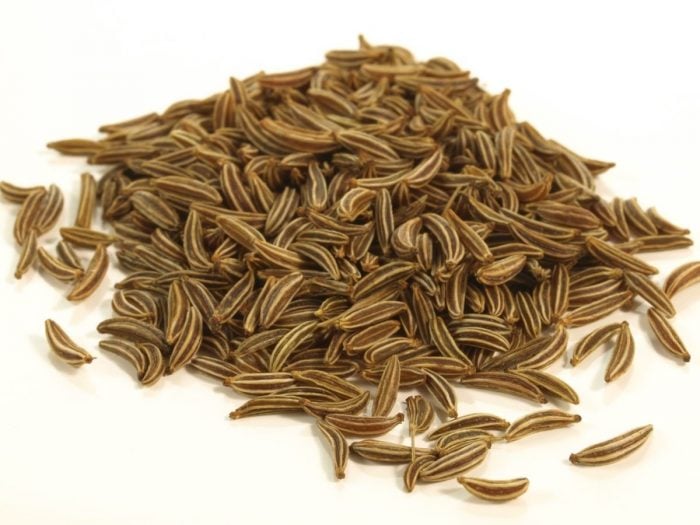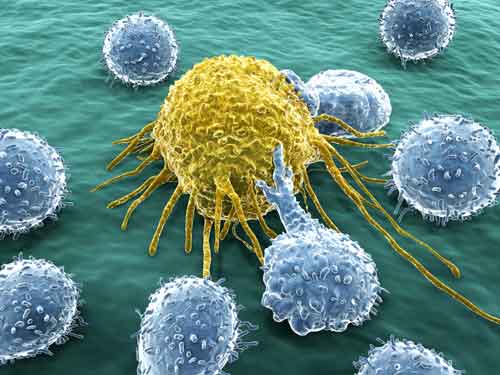The health benefits of cumin include its ability to aid in digestion, improve immunity and treat piles, insomnia, respiratory disorders, asthma, bronchitis, common cold, lactation, anemia, skin disorders, boils and cancer.
Many of you might remember having hated those curries and soups which had roasted or fried cumin seeds in them when you were kids, because they looked like small black insects. However, you probably liked the taste. So your mother might have removed these flavorful parts before she served you the food. That was cumin!
Cumin, scientifically known as Cuminun Cyminum belongs to family Apiaceae and is extensively used in culinary practices of the Indian Subcontinent and some other Asian, African and Latin American countries as a condiment or spice. Those who are of the opinion that spices are bad for one’s health should note that cumin can be beneficial for some of the most dangerous diseases, and is generally consider a boost for overall health. Let’s explore just how it benefits your health in the section below.
Health Benefits of Cumin
The health benefits of cumin include the following:
Digestion: Cumin is extremely good for digestion and related problems. The very aroma of cumin, which comes from an aromatic organic compound called Cuminaldehyde, the main component of its essential oil, activates our salivary glands in our mouth, which facilitates the primary digestion of food. Next is thymol, a compound present in cumin, which stimulates the glands that secrete acids, bile and enzymes responsible for complete digestion of the food in the stomach and the intestines. Cumin is also Carminative, which means that it relieves from you from gas troubles and thereby improves digestion and appetite. Due to its essential oils, magnesium and sodium content, cumin promotes digestion and also gives relief for stomach-aches when taken with hot water.
Piles: The main cause behind piles (hemorrhoids) is constipation added with infections in the wound in the anal tract, which are also caused by constipation. Cumin, because of its dietary fiber content and carminative, stimulating, antifungal and antimicrobial properties, acts as a natural laxative in powdered form. These characteristics are due to the presence of essential oils comprised mainly of Cuminaldehyde and certain pyrazines. Adding cumin to your diet also helps in healing up of infections or wounds in the digestive and excretory system and speeds up digestion as well. That pretty much means that cumin clears up all of the symptoms and causes of hemorrhoids, so keep that it mind when you start itching!
Diabetes: Although research is still ongoing, early studies report that cumin, among a number of other spices, can have a powerful effect in preventing diabetes by reducing the chances of hypoglycemia. The animals that were tested showed a sharp decline in hypoglycemia when fed cumin seeds in their diet, and they also showed a decrease in glucosuria, which is a condition where the urine contains too much glucose, also resulting in hypoglycemia and diabetes. Human testing is ongoing, but early reports show that cumin can be a very powerful tool in the battle against diabetes!
Insomnia: This is a very peculiar property of cumin. It is a stimulant as well as a relaxant at the same time. This property cannot be attributed to a single component alone, just as causes of insomnia cannot be attributed to a single cause. However, studies show that the proper intake of vitamins (particularly B-complex) and good digestion help to induce a sound sleep. Cumin helps in both of these factors. Some of the components of cumin essential oil are hypnotic in nature and have tranquilizing effects, which also help to relieve stress and anxiety that commonly causes insomnia.
Respiratory Disorders, Asthma, Bronchitis: The presence of caffeine (the stimulating agent), and the richly aromatic essential oils (the disinfectants) make cumin an ideal anticongestive combination for those suffering from respiratory disorders such as asthma and bronchitis. It acts as expectorant, meaning that it loosens up the accumulated phlegm and mucus in the respiratory tracts and makes it easier to eliminate them from the system via sneezing or coughing up and spitting. By eliminating as much of the mucus and phlegm as possible, it can inhibit the formation of additional material and help to heal the initial condition that led to its formation in the first place.
Common Cold: The common cold is a viral infection which affects our body frequently when our immune system becomes weakened or vulnerable. Again, the essential oils present in cumin act as disinfectants and help fight viral infections which can cause the common cold. Cumin also suppresses the development of coughing in the respiratory system since it dries up the excess mucus. Cumin is rich in iron and has considerable amount of vitamin-C, which are essential for a healthy immune system and keeps infections from forming or becoming worse. Vitamin-C is also a natural antioxidant, so it defends against other infections and toxins as well, further boosting the immune system.
Lactation: Cumin is rich in iron and thus very good for lacting mothres as well as for women who are undergoing menses or who are pregnant, since they are more in need of iron than others. Moreover, cumin is said to help ease and increase secretion of milk in lactating women due to the presence of thymol, which tends to increase secretions from our glands, including milk, which is a secretion from the mammary glands. Also, cumin is more beneficial if taken with honey. Cumin has remarkable amount of calcium (more than 900 mg per 100 grams) which accounts for over 90% of our daily requirement of calcium. This calcium is an important constituent of milk and hence cumin is very good for lactating mothers.

Anemia: As stated above, cumin is very rich in ironn (more than 66 mg. in every 100 grams) which is more than 5 times the daily requirement of iron for an adult. This iron is the main constituent of hemoglobin in the red blood corpuscles of blood. It is hemoglobin which transfers oxygen (as the oxide of iron) to the body’s cells and whose deficiency causes anemia. So, cumin can be a nutritious additive to daily diet for anemic people and avoid the symptoms of anemia like fatigue, anxiety, cognitive malfunction, and digestive issues.

Anemia: As stated above, cumin is very rich in ironn (more than 66 mg. in every 100 grams) which is more than 5 times the daily requirement of iron for an adult. This iron is the main constituent of hemoglobin in the red blood corpuscles of blood. It is hemoglobin which transfers oxygen (as the oxide of iron) to the body’s cells and whose deficiency causes anemia. So, cumin can be a nutritious additive to daily diet for anemic people and avoid the symptoms of anemia like fatigue, anxiety, cognitive malfunction, and digestive issues.
Concentration and Cognitive Malfunction: The amount of iron in cumin leads to increased hemoglobin production and subsequent prevention of anemia, but that increased blood flow has other benefits as well. When your blood circulation is in top form, adequate amounts of oxygen are able to reach the organs and the brain, leading to optimal performance of those bodily systems. Proper amounts of oxygen and iron in the brain lead to increased cognitive performance and a decrease in cognitive disorders like Alzheimer’s disease and dementia. For other organs, increased oxygenation increases efficiency and speeds up the metabolism, which can boost your overall health, increase strength, and prevent signs of aging.
Skin Disorders: Almost everyone knows that vitamin-E is good for the maintenance of skin and the prevention of premature aging symptoms. It keeps the skin young and glowing. This vitamin is also present in abundance in cumin. The essential oils present in cumin have disinfectant and antifungal properties. This prevents any microbial and fungal infection from affecting the skin. Not all skin issues are disorders or infections, some of them are simply signs of aging. Vitamin E acts as an antioxidant in this regard and combats the free radicals that attack the skin and result in signs of premature aging like wrinkles, age spots, and sagging skin. This, combined with the antibacterial capacity of cumin, makes for healthy, beautiful skin that lasts far into your old age.
 Boils: Boils are outlets for the removal of toxic substances and foreign matters such as microbes from the body. This means that they are symptoms which show that a high amount of toxic substances have accumulated in the body. In this way, cumin can help you a great deal. Those who regularly use cumin in food have a significant reduction in the occurance of boils, rashes, pimples, and other signs of excess toxin content. Components such as cuminaldehyde, thymol, and phosphorus are good detoxifying agents which help in the regular removal of toxins from the body. The healthy way of removing toxins is through the excretory system, not through boils.
Boils: Boils are outlets for the removal of toxic substances and foreign matters such as microbes from the body. This means that they are symptoms which show that a high amount of toxic substances have accumulated in the body. In this way, cumin can help you a great deal. Those who regularly use cumin in food have a significant reduction in the occurance of boils, rashes, pimples, and other signs of excess toxin content. Components such as cuminaldehyde, thymol, and phosphorus are good detoxifying agents which help in the regular removal of toxins from the body. The healthy way of removing toxins is through the excretory system, not through boils.
Immunity: As discussed above, an abundance of iron, the presence of essential oils, vitamin-C, and vitamin-A in cumin boosts our immune system in a number of ways. Vitamin C is one of the most powerful antioxidants that we have in our body, and it also stimulates the function and activity of white blood cells. As an antioxidant, vitamin C fights the detrimental effects of free radicals, which are the dangerous byproducts of cellular metabolism. They are constantly being created in the body, and therefore, must be constantly eliminated. Antioxidants neutralize free radicals that lead to many diseases, including, but not limited to, cardiovascular diseases and cancer.
Cancer: Cumin itself has detoxifying and chemopreventive properties, and accelerates the secretion of detoxifying and anticarcinogenic enzymes from the glands, as it also does to other secretions. Furthermore, it has beneficial antioxidants like vitamin-C and vitamin-A within its chemical makeup, in addition to those essential oils. Besides having countless other benefits, the antioxidants have anticarcinogenic properties too, and those found in cumin are particularly good for colon cancer prevention.
Other benefits: Even more? Cumin is also beneficial in treating renal coli, weak memory, insect bites and painful stings. With all of these benefits, how could you say no? Add some cumin to your diet as soon as you can!











